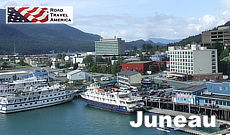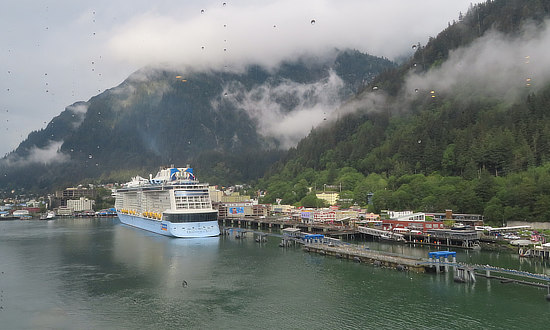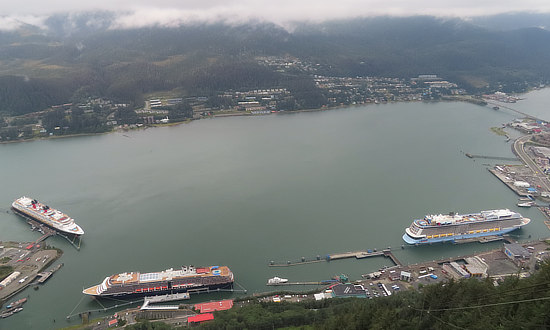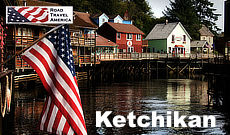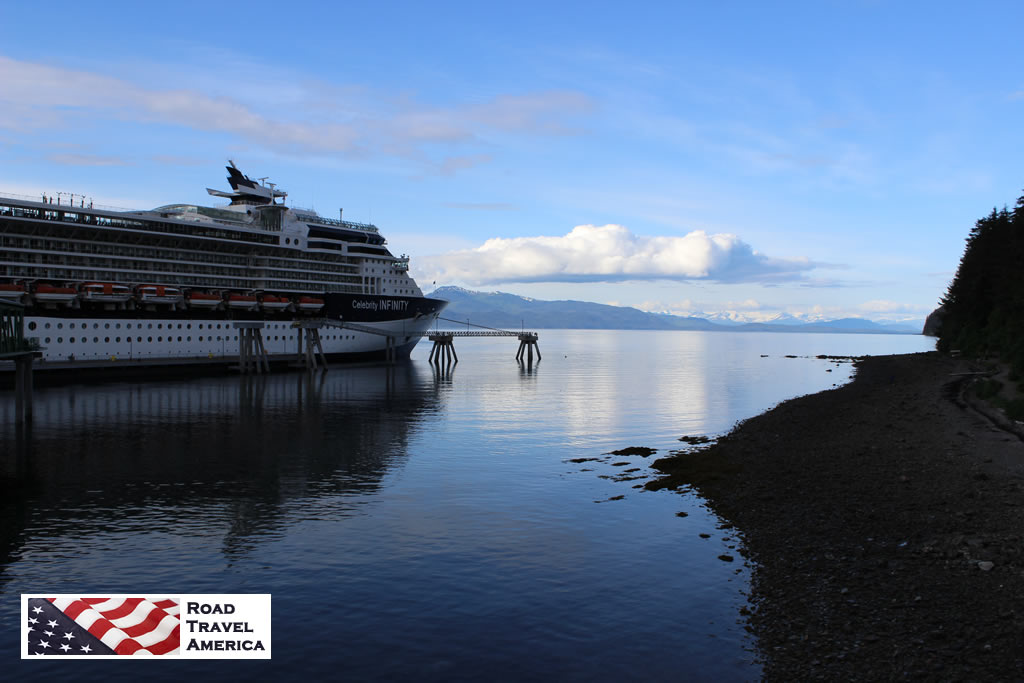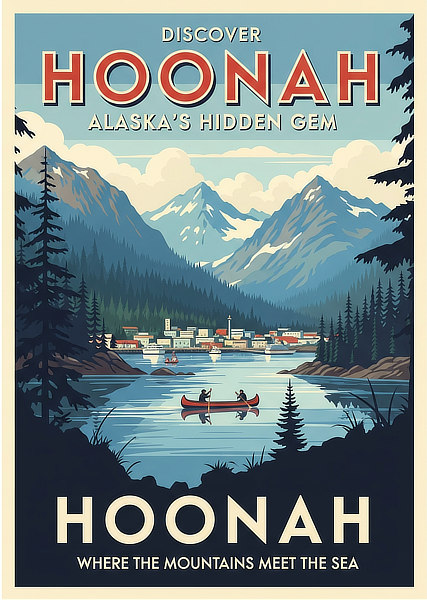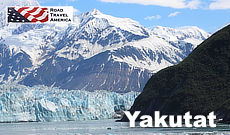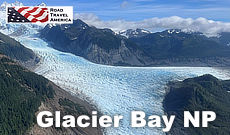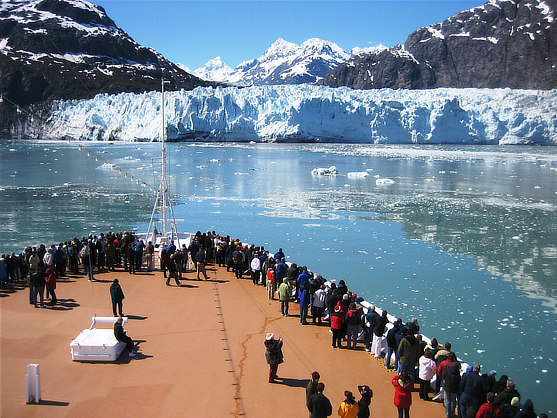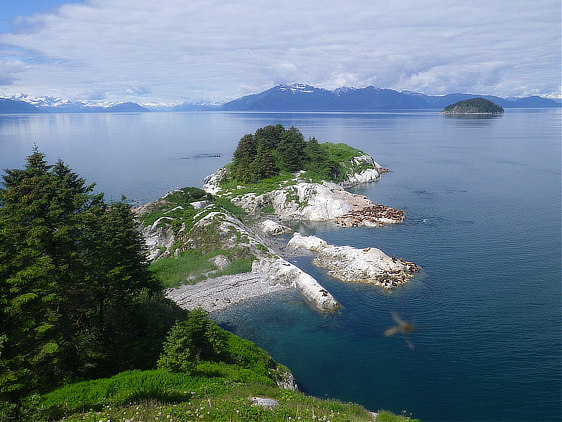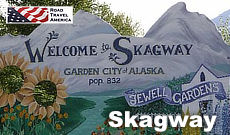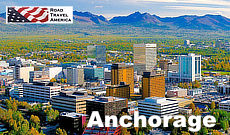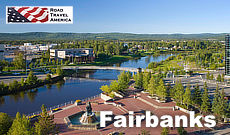
Alaska Cruise Travel Guide 2025
Alaska is a huge state, with so many options for travel, vacations and exploration!
The largest state (in area) of the United States, Alaska was admitted to the union as the 49th state in 1959, and lies at the extreme northwest of the North American continent.
 Alaska ... the 49th State |
Alaska is divided into five regions: far north, interior, southwest, south central, and Inside Passage. Although it takes a long time to see the entire state, visitors can travel through the regions by ferry, car, bus, cruise ship or airplane.
Of the 20 highest peaks in the United States, 17 are in Alaska. Denali, the highest peak in North America, is 20,320 ft. above sea level. Denali, the Indian name for the peak, means "The Great One."
The Yukon River, almost 2,000 miles long, is the third longest river in the U.S. There are more than 3,000 rivers in Alaska and over 3 million lakes. The largest, Lake Iliamna, encompasses over 1,000 square miles.
Alaska has an estimated 100,000 glaciers, ranging from tiny cirque glaciers to huge valley glaciers. There are more active glaciers and ice fields in Alaska than in the rest of the inhabited world. The largest glacier is the Malaspina at 850 square miles. Five percent of the state, or 29,000 square miles, is covered by glaciers.
By area, Alaska holds more than half of America’s national park lands. With 17 national park units and 16 national wildlife refuges, the options for visits and vacations are plentiful.
Alaska is a premier cruise ship destination in the United States, with stops in destinations like Anchorage, Sitka, Juneau, Skagway, Glacier Bay, Ketchikan and Hoonah. Most ships depart from Seattle, Washington, or Vancouver, British Columbia.
| Cruise ship awaiting departure from Vancouver's Canada Place |
 |
The Port of Vancouver’s cruise terminal at Canada Place welcomes upwards of 900,000 passengers each year as the homeport for many Alaska cruises. The three-berth terminal can service up to four luxury cruise ships at one time. The terminal is owned and operated by the Vancouver Fraser Port Authority.
Map of the Major Port Cities in Alaska
 |
Popular Cruise Destinations in Alaska
JuneauThe City and Borough of Juneau is the capitol of Alaska, located on the Gastineau Channel and the Alaskan Panhandle. Juneau is about 235 air miles north of Ketchikan and 40 miles east of Hoonah. It is situated at the base of Mount Juneau and across the channel from Douglas Island. The Juneau-Douglas Bridge connects the Juneau mainland with Douglas Island. Juneau shares its eastern border with the Canadian province of British Columbia. It is the only U.S. state capital to border another country. There are no roads connecting Juneau to the rest of North America, although cars can use the ferries to connect to the road network. The longest road is Glacier Highway, Alaska Route 7, which extends 40 miles north of downtown. Leaving downtown, the route is known as Egan Drive until the airport. The extreme southern end of Egan Drive is known as Marine Way. Beyond the airport, AK-7 continues north as the Glacier Highway, past Auke Bay to its northernmost point near Berners Bay. The cruise port downtown can accomodate four ships at the same time; plus another ship can anchor offshore and tender in.Read more about Juneau
|
|||
 |
|||
Cruise to KetchikanKetchikan, Alaska, is located on Revillagigedo Island in the Alexander Archipelago, part of the southern portion of Alaska’s Inside Passage (Southeast) region. The only way to travel to and from Ketchikan is by boat or plane. It is built on steep hillsides, with some structures built on pilings It is about 235 air miles south of the Alaska Capitol in Juneau and 700 miles northwest of Seattle. Ketchikan was incorporated in 1900 and is named after the Ketchikan Creek streaming into town from the hills above. It is known as the First City of Alaska and the Gateway to Southeast Alaska, because it’s the first town on a northbound travel to Alaska. Long a popular destination for travelers, Ketchikan is Alaska’s second largest cruise port. Visitors enjoy fishing, wildlife viewing, outdoor recreation, thriving native culture and amazing scenery. Read more about Ketchikan
|
Cruise to Hoonah and Icy StraitHoonah is situated on the northwest shore of Chichagof Island across Icy Strait from the entrance to Glacier Bay on Alaska’s scenic Inside Passage. Initially a Tlingit village, Hoonah remains the largest Tlingit community today and members of the Hoonah Tlingit tribe have lived in the area for thousands of years. Known as the Little City with a Big Heart, Hoonah is a family-oriented and closely-knit community of friendly and caring people. Hoonah, being an island community, is only accessible by boat or plane. The Alaska Marine Highway serves Hoonah with the M/V LeConte which offers residents a slower but more dependable and cheaper option to travel to and from Hoonah to Juneau. Hoonah is home to Icy Strait Point, one of the world’s most productive salmon canneries. The facility was initially built in 1912 and then re-built in the early 2000s to become a port for cruise ships. Today, a number of cruise lines have Hoonah as one of their frequent stops. The cannery also houses a museum, local arts and crafts shops, restaurants, the ZipRider, and a cannery line display from the mid-1930’s which makes it a great attraction for visitors. During May through September, cruise ships from Royal Caribbean, Celebrity, Holland America, NCL, Princess, Seabourn, Viking, Carnival and other lines dock in Hoonah and provide a variety of shore excursions. Read more about Hoonah and Icy Strait
|
||||
Yakutat and the Hubbard GlacierLocated on the scenic Gulf of Alaska, Yakutat is 226 nautical miles from Juneau and 302 nautical miles from Whittier. Yakutat is situated on a glacial moraine, surrounded by the highest coastal mountains on earth, and has been inhabited for hundreds of years by the Tlingit people, now known as the Yakutat Tlingit Tribe. We have driven dozens of road trips all across North America! But one of our favorite destinations, Yakutat, is not accessible by car, truck or SUV. Surrounded by Wrangell-St. Elias National Park and Preserve and the Tongass National Forest, Yakutat attracts a wide variety of outdoor enthusiasts to hike beaches, float rivers, explore bays and passages, climb mountains, view glaciers, snowboard, and surf remote breaks. Also a world-class birding destination, Yakutat provides the opportunity to view over 200 species including many rarities. The Hubbard Glacier is located about 30 miles north off the coast of Yakutat and is by far one of Alaska’s most exciting natural treasures. It is the longest tidewater glacier in the world. Dramatically massive at about 7-miles wide, 76-miles long and as tall as a 30-story building above the waterline, it’s the largest river of ice in North America. Read more about Yakutat and the Hubbard Glacier
|
||||
Glacier Bay National Park and Preserve
The area was designated a national monument in 1925, and Glacier Bay National Park & Preserve was formed in 1980. Located in southeast Alaska west of Juneau, the park covers 3,284,500 acres, or 5,220 square miles. The park and preserve occupy the northernmost section of the southeastern Alaska coastline, between the Gulf of Alaska and Canada. The Canada-US border approaches to within 15 miles (24 km) of the ocean. The highest peak is Mount Fairweather, at 15,308 feet above sea level. It's a marine park, where great adventure awaits by boating into inlets, coves and hideaway harbors. It's also a land park, with its snow-capped mountains, spectacular glaciers, and emerald green forests. The National Park Service manages vessel traffic (including cruise ships) in Glacier Bay to protect natural and cultural resources, provide for a range of visitor experiences, and promote visitor satisfaction and understanding. On a cruise to Glacier Bay, visitors can expect breathtaking views of towering glaciers, dramatic mountain landscapes, and intact ecosystems. The journey offers a chance to witness calving glaciers, where large chunks of ice break off and crash into the sea. Wildlife sightings are frequent, with opportunities to see brown bears, sea otters, humpback whales, and a variety of seabirds. Knowledgeable park rangers will board the ship to provide insights into the park's ecology and history, enhancing the overall experience. Cruise ships do not dock anywhere in Glacier Bay National Park. Ships typically spend a full day (9-10 hours) in Glacier Bay including a stop at a major tidewater glacier. Park rangers set up a information desk while on board ship in a primary viewing lounge. Read more about Glacier Bay National Park and Preserve in Alaska
|
SkagwayA colorful history, scant rain and a lot of cruise ships makes a Skagway one of the most interesting and popular towns to visit in the Inside Passage. Skagway rarely disappoints visitors. A seven-block corridor along Broadway features historic false-front shops and restaurants, wooden sidewalks, locals in period costumes and restored buildings, many of which are part of the National Park Service-managed Klondike Gold Rush National Historical Park. Today Skagway survives almost entirely on tourism, as more than 400 cruise ships and a million cruise passengers a year turn this small town into a boomtown again every summer. Read more about Skagway at TravelAlaska.com |
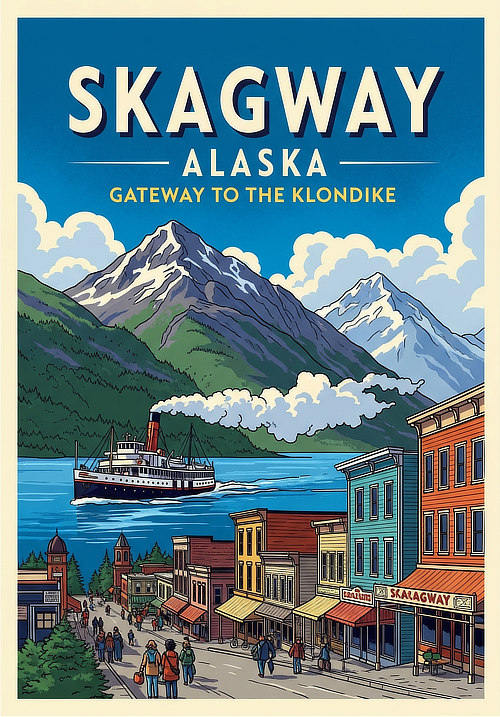 |
Cruise to Seward: Visiting Kenai Fjords National Park
Seward is a departure point and destination for large cruise ships from Celebrity Cruises, Holland America Line, Royal Caribbean International and others.
Many cruise ships that cross the Gulf of Alaska end or start their itineraries in Seward, making it a popular spot to start pre- or post-cruise land-based tours.
Cruise tours originating from Seward provide access to the Kenai Fjords National Park via Resurrection Bay. Various companies offer tours, many guided by National Park Rangers.
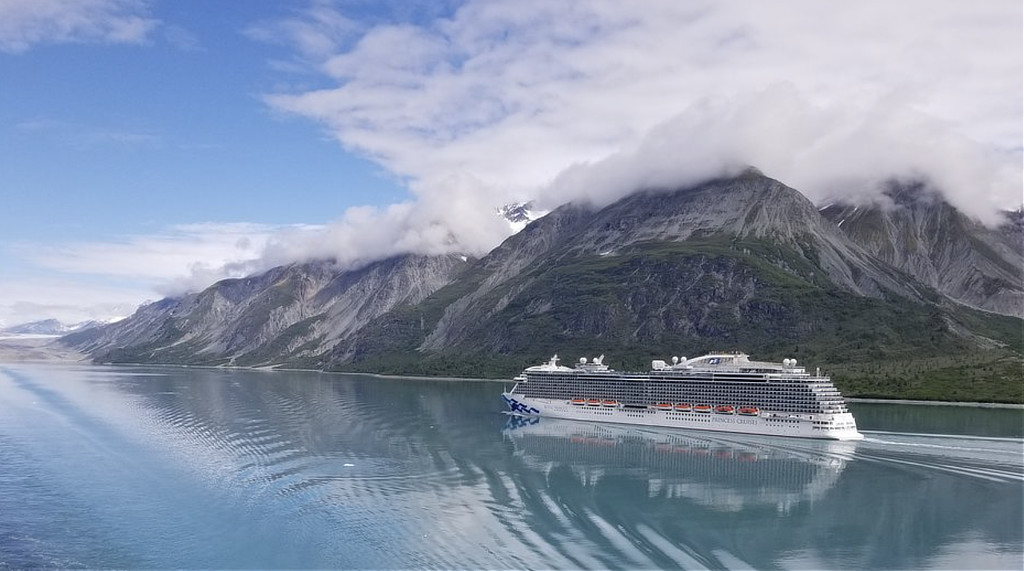 |
| Holland America Line "Westerdam" docked at Seward |
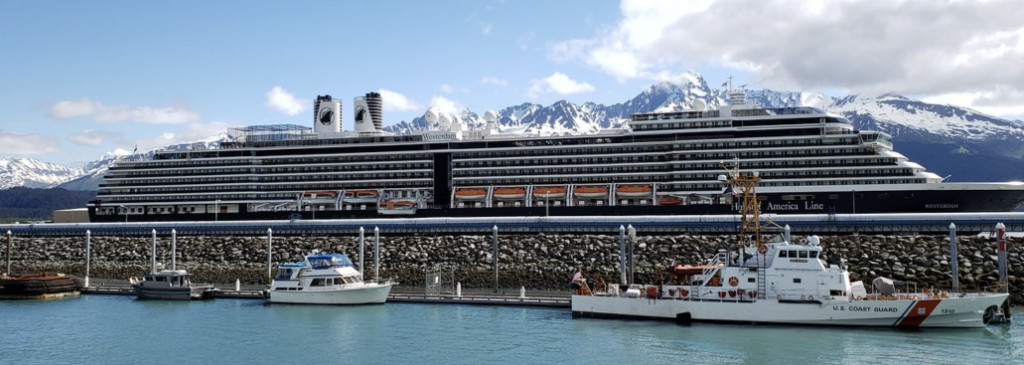 |
Anchorage
Alaska’s largest city, Anchorage, lies between the mountains and the sea and yet is no stranger to the wilderness. There is no other urban area like it. Among the northernmost cities on Earth, Anchorage is a place with big-city amenities: fine restaurants, museums, theaters and an excellent music scene. Creating the backdrop are the salmon-rich waters of Cook Inlet and the 5,000-foot-plus peaks of Chugach State Park. Within a short drive from downtown are dozens of wilderness adventures and a short plane ride opens up the possibility of almost any type adventure. That’s one reason why Anchorage’s Lake Hood is the world’s busiest floatplane base. Anchorage’s more than 290,000 residents embrace both the urban amenities and the wilderness beyond it. Read more about Anchorage at TravelAlaska.com |
Fairbanks
At 65 degrees north latitude, Fairbanks is renowned for the aurora borealis, the midnight sun and sunsets and sunrises that last forever. Basecamp to Denali National Park, the Interior and the Arctic – Fairbanks is the Golden Heart of Alaska. Home to just over 100,000 hearty souls, the Fairbanks region is the second-largest population center in Alaska. Fairbanks is one of Alaska's best year-round destinations and visitors will find plenty to do whether they come for the long, warm summer days or to watch spectacular northern lights displays color the night sky during Aurora Season. With the summer sun shining up to 24 hours a day during the Midnight Sun Season from April 22 to August 20, the subarctic summer is filled with action and brimming with growth. In fact, from mid-May through mid-July Fairbanks experiences 70 straight days of daylight! Read more about Fairbanks at TravelAlaska.com |
Popular Cruise Lines Sailing to Alaska
| Cruise Line International Association (CLIA) - Alaska | |
Alaska Hotels, Restaurants and Traveler Reviews
More Information and Resources about Alaska |
|
